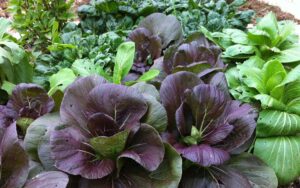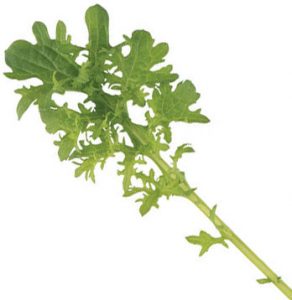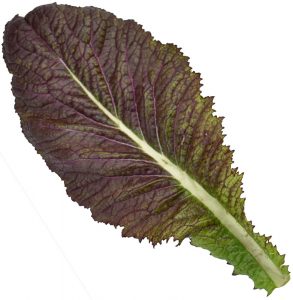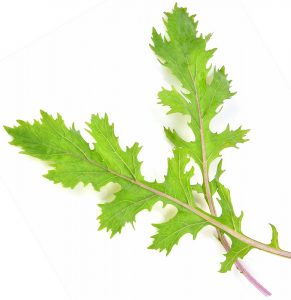Growing mustard greens or mizuna
 Robin Gale-Baker, from Sustainable Macleod, discusses growing lettuce. This is one of a series of articles she has written about growing various veggies (see right hand sidebar). She has also written a number of articles about growing various herbs, growing various fruit trees and general growing techniques.
Robin Gale-Baker, from Sustainable Macleod, discusses growing lettuce. This is one of a series of articles she has written about growing various veggies (see right hand sidebar). She has also written a number of articles about growing various herbs, growing various fruit trees and general growing techniques.
Want a leafy green to add to your salad which has a peppery bite (but is a bit milder than rocket) and that you can grow all year round? If so, try either mustard greens or mizuna (they taste similar). There are lots of varieties of mustard greens and, whilst they mostly taste similar, their leaves (and therefore both texture and mouth feel) vary substantially, from the large-leaved ‘Red Giant’ to the thin, frilly-leaved ‘Golden Frills’.
 |
 |
 |
| Mustard greens ‘golden frills’ | Mustard greens ‘red giant’ | Mizuna |
While some mustard greens are widely used (especially in Asian cuisine), most are not well known in Australia. This is a pity as they are healthy, tasty, quick growing, and definitely best when harvested fresh from the garden. Just as mustard has quite a bite, so do the leaves of mustard greens. They are great for salads when young, and good in stir fries when a bit older.
Edible mustard greens are members of the genus Brassica, and more specifically from the species Brassica juncea and Brassica rapa. As such, they are related to cauliflower, cabbage and broccoli, all of which are Brassica oleracea.
You can buy their seeds at most online seed websites and/or you can buy their seedlings at many nurseries.
Varieties of Brassica juncea
These include Japanese Giant Red Mustard or Mustard ‘Red Giant’, Frills (golden, purple or scarlet), Mizuna (both green and purple), Green Wave, Wasabina, Curled Mustard, Southern Giant, Golden Streaks, Osaka Purple, Gai Choi, Tender Green and Yukina Savoy.
The Tatsoi variety (sometimes classified as Brassica rapa) has less of a peppery taste but looks beautiful whilst growing.
Varieties of Brassica rapa
These include Mustard Spinach Komatsuna, Tokyo Bekana and Japanese Mibuna.
The Pak Choi, Bok Choy and Napa Cabbage varieties have less of a peppery taste but are widely used in stir fries.
Other mustards
There are two other main types of mustard.
Black mustard (Brassica nigra), brown mustard (a variety of Brassica juncea) and white mustard (Sinapis alba) are all grown for their seeds, which are used to make mustard.
Mustard biofumigant (a variety of Brassica napus) is a non-edible type of mustard grown as a soil fumigant. This plant releases compounds that attack soil-borne diseases and disinfects the soil. It is a long-term crop, meaning that it needs to grow for, say, 5 months and then be dug back into the bed.
Site and soil
Choose a sunny site or area of partial sun depending on the season. The soil should be well drained and contain plenty of organic matter. The soil should not dry out and should be kept weed-free.
Planting
Sow the seed directly into the soil at a depth of about 5cm. I prefer to broadcast the seed across the soil and then cover. Grow plants tightly together (rather than plant in rows) as this deters pests from eating the leaves. Germination takes 7-14 days.
You can plant mustard greens or mizuna at any time of year noting that, like other leafy greens, they tend to bolt early if grown over summer.
Pests
Pests include caterpillars, slugs, snails and earwigs. Use a deterrent for caterpillars, slugs and snails. For earwigs, put some stakes in the bed and place a down-turned pot stuffed with newspaper on top of the stake. The earwigs will head for the pot of newspaper and you can remove the pot daily or every few days and dispose of the paper and earwigs. Netting them is another option, but secure the hem to the ground to keep crawling pests out. Netting also prevents white cabbage butterflies laying eggs on the leaves, preventing the hatched caterpillars from stripping the juicy leaves, leaving only the ribs and veins.
Harvesting
Snip most leaves for use when they are 10-15cm high. They will still be tender at this height. You can also grow them as microgreens, snipping them when they are about 3cm high.
